In-depth Financial Analysis of PPHE Hotel Group and ABHL Report
VerifiedAdded on 2023/04/26
|28
|5899
|103
Report
AI Summary
This report delivers a comprehensive financial analysis of PPHE Hotel Group and Andrew Brownsword Hotels Limited, utilizing ratio analysis to evaluate profitability, asset management, liquidity, and investor relations for both entities. It delves into the cost of capital for PPHE, determining its cost of equity and valuing its share price through forecasting and growth factor analysis. Furthermore, the report examines PPHE's share price movements, identifying key influencing factors, and assesses the potential impact of acquiring Andrew Brownsword Hotels on PPHE's financial statements, exploring possible synergy effects. The analysis includes horizontal and vertical assessments of financial statements, supported by charts and graphs visualizing revenue and profit trends. Key financial ratios are computed and compared over a three-year period (2015-2017) to provide insights into the financial health and performance of both hotel groups.
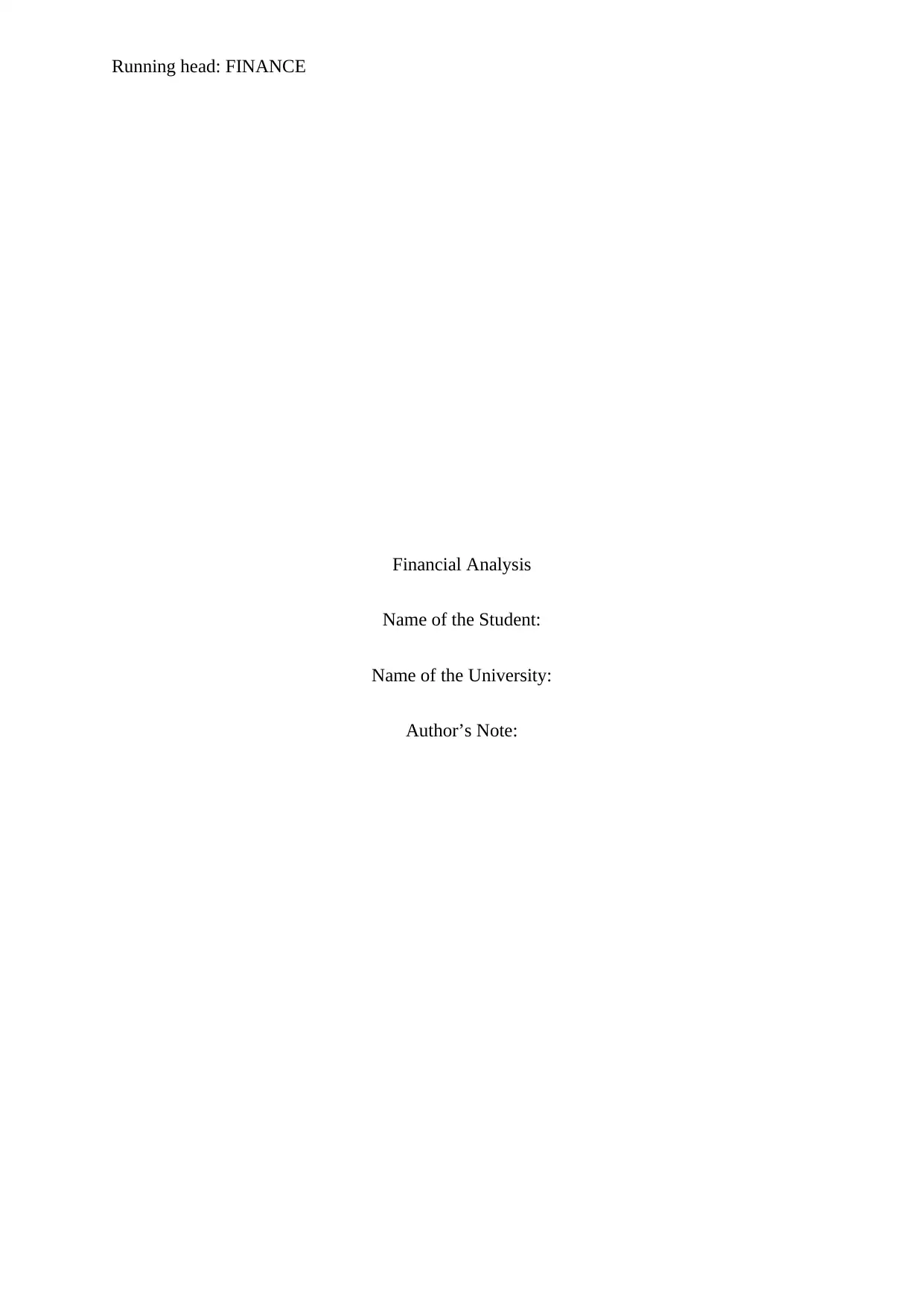
Running head: FINANCE
Financial Analysis
Name of the Student:
Name of the University:
Author’s Note:
Financial Analysis
Name of the Student:
Name of the University:
Author’s Note:
Paraphrase This Document
Need a fresh take? Get an instant paraphrase of this document with our AI Paraphraser
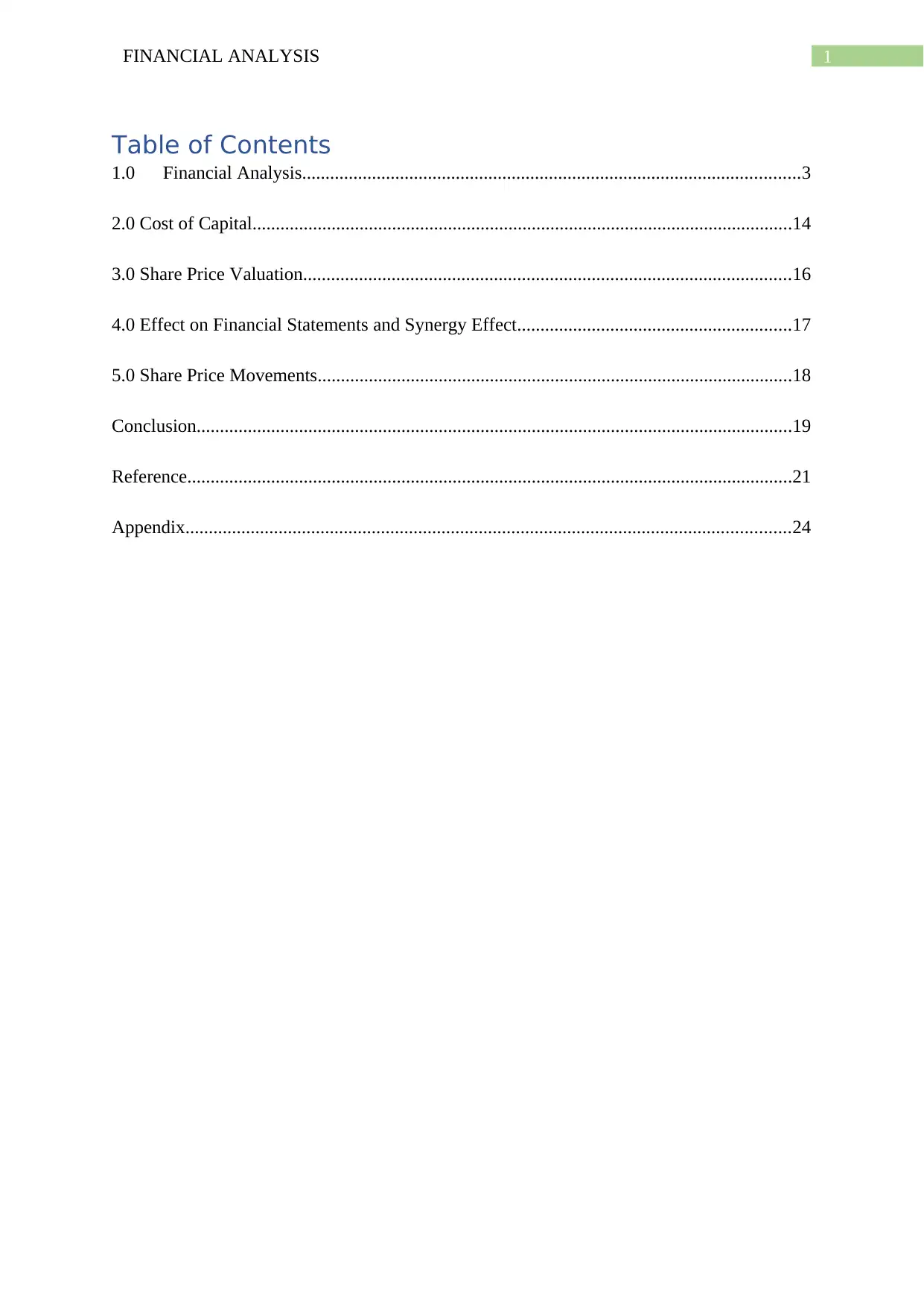
1FINANCIAL ANALYSIS
Table of Contents
1.0 Financial Analysis...........................................................................................................3
2.0 Cost of Capital....................................................................................................................14
3.0 Share Price Valuation.........................................................................................................16
4.0 Effect on Financial Statements and Synergy Effect...........................................................17
5.0 Share Price Movements......................................................................................................18
Conclusion................................................................................................................................19
Reference..................................................................................................................................21
Appendix..................................................................................................................................24
Table of Contents
1.0 Financial Analysis...........................................................................................................3
2.0 Cost of Capital....................................................................................................................14
3.0 Share Price Valuation.........................................................................................................16
4.0 Effect on Financial Statements and Synergy Effect...........................................................17
5.0 Share Price Movements......................................................................................................18
Conclusion................................................................................................................................19
Reference..................................................................................................................................21
Appendix..................................................................................................................................24
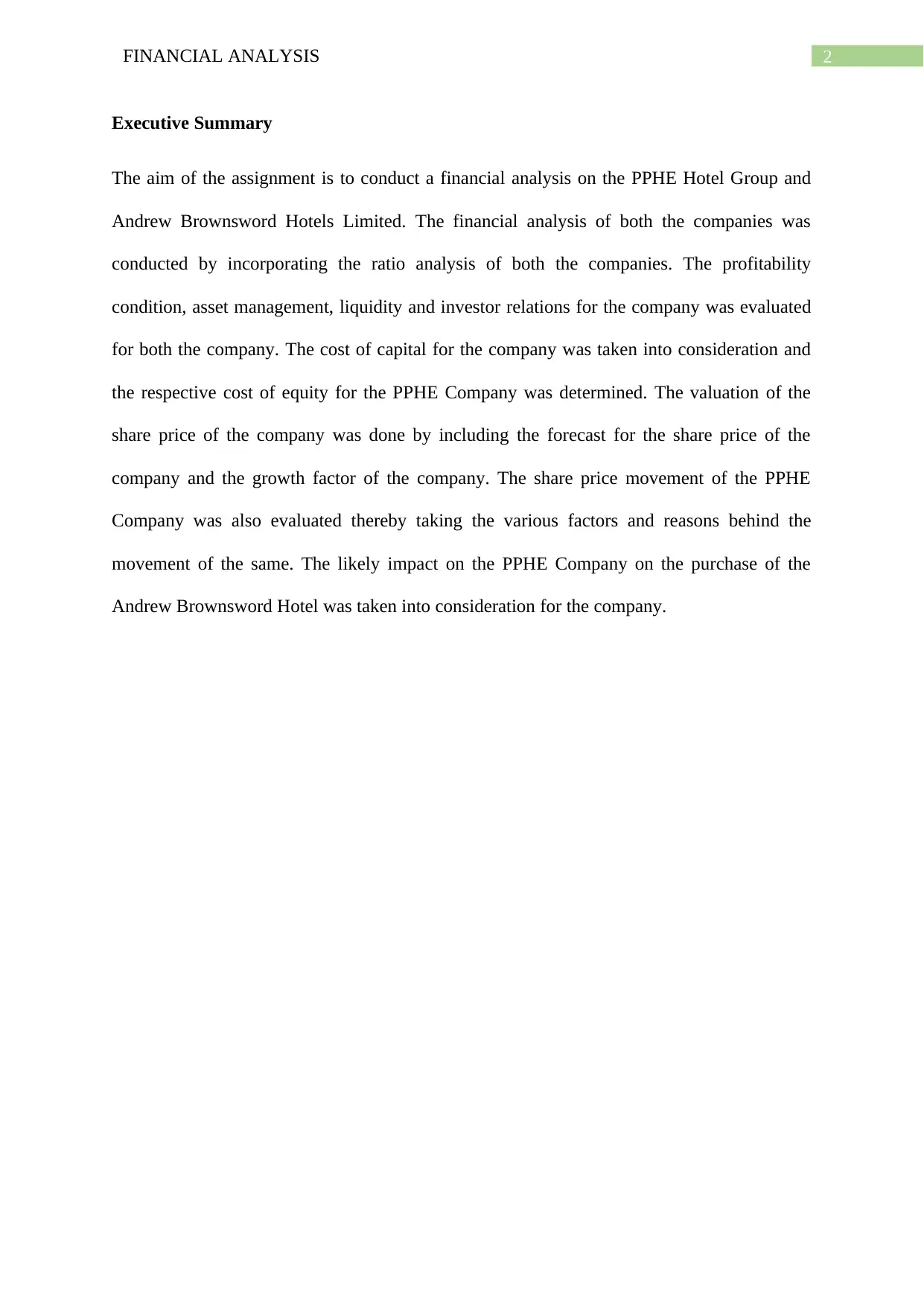
2FINANCIAL ANALYSIS
Executive Summary
The aim of the assignment is to conduct a financial analysis on the PPHE Hotel Group and
Andrew Brownsword Hotels Limited. The financial analysis of both the companies was
conducted by incorporating the ratio analysis of both the companies. The profitability
condition, asset management, liquidity and investor relations for the company was evaluated
for both the company. The cost of capital for the company was taken into consideration and
the respective cost of equity for the PPHE Company was determined. The valuation of the
share price of the company was done by including the forecast for the share price of the
company and the growth factor of the company. The share price movement of the PPHE
Company was also evaluated thereby taking the various factors and reasons behind the
movement of the same. The likely impact on the PPHE Company on the purchase of the
Andrew Brownsword Hotel was taken into consideration for the company.
Executive Summary
The aim of the assignment is to conduct a financial analysis on the PPHE Hotel Group and
Andrew Brownsword Hotels Limited. The financial analysis of both the companies was
conducted by incorporating the ratio analysis of both the companies. The profitability
condition, asset management, liquidity and investor relations for the company was evaluated
for both the company. The cost of capital for the company was taken into consideration and
the respective cost of equity for the PPHE Company was determined. The valuation of the
share price of the company was done by including the forecast for the share price of the
company and the growth factor of the company. The share price movement of the PPHE
Company was also evaluated thereby taking the various factors and reasons behind the
movement of the same. The likely impact on the PPHE Company on the purchase of the
Andrew Brownsword Hotel was taken into consideration for the company.
⊘ This is a preview!⊘
Do you want full access?
Subscribe today to unlock all pages.

Trusted by 1+ million students worldwide
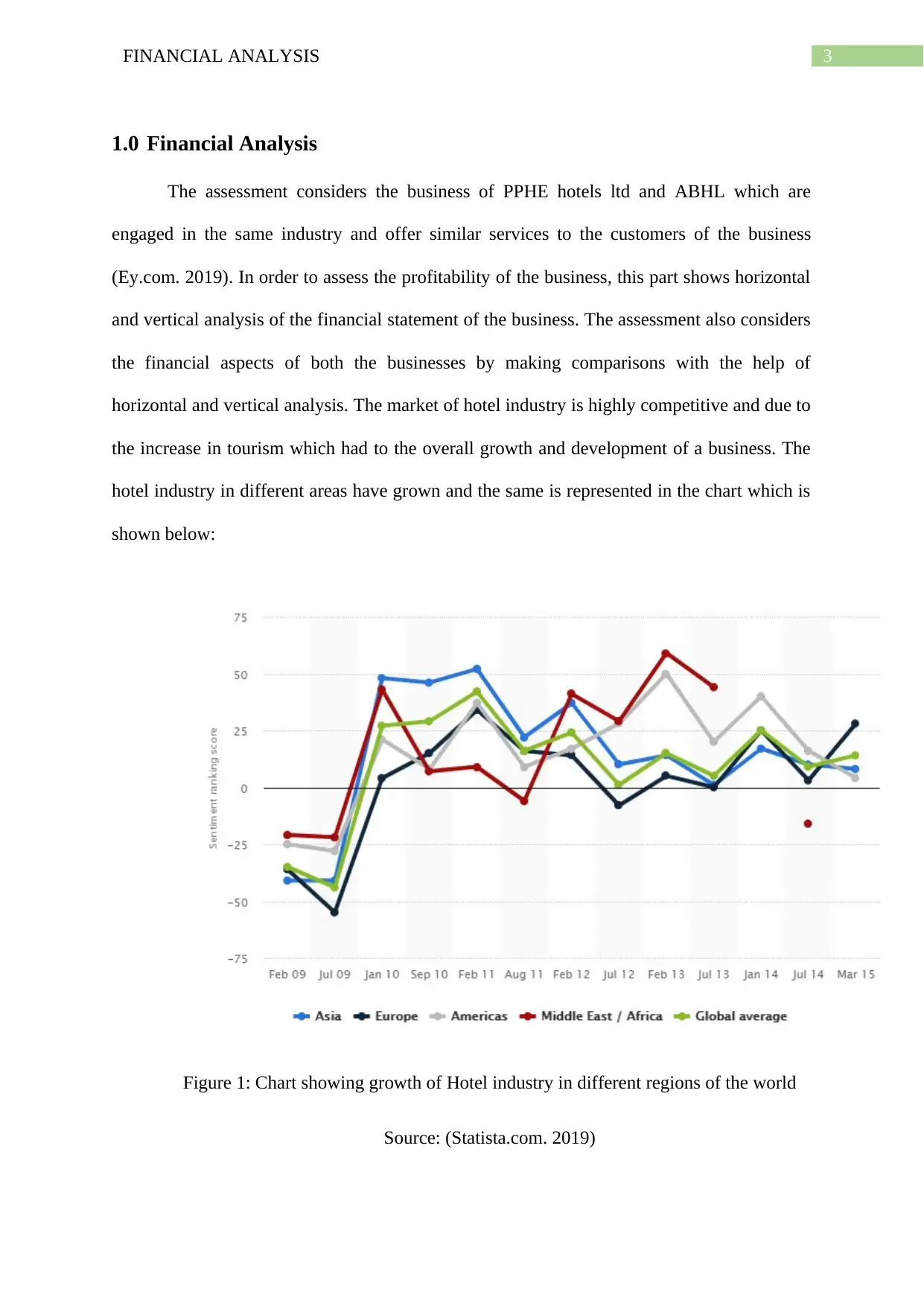
3FINANCIAL ANALYSIS
1.0 Financial Analysis
The assessment considers the business of PPHE hotels ltd and ABHL which are
engaged in the same industry and offer similar services to the customers of the business
(Ey.com. 2019). In order to assess the profitability of the business, this part shows horizontal
and vertical analysis of the financial statement of the business. The assessment also considers
the financial aspects of both the businesses by making comparisons with the help of
horizontal and vertical analysis. The market of hotel industry is highly competitive and due to
the increase in tourism which had to the overall growth and development of a business. The
hotel industry in different areas have grown and the same is represented in the chart which is
shown below:
Figure 1: Chart showing growth of Hotel industry in different regions of the world
Source: (Statista.com. 2019)
1.0 Financial Analysis
The assessment considers the business of PPHE hotels ltd and ABHL which are
engaged in the same industry and offer similar services to the customers of the business
(Ey.com. 2019). In order to assess the profitability of the business, this part shows horizontal
and vertical analysis of the financial statement of the business. The assessment also considers
the financial aspects of both the businesses by making comparisons with the help of
horizontal and vertical analysis. The market of hotel industry is highly competitive and due to
the increase in tourism which had to the overall growth and development of a business. The
hotel industry in different areas have grown and the same is represented in the chart which is
shown below:
Figure 1: Chart showing growth of Hotel industry in different regions of the world
Source: (Statista.com. 2019)
Paraphrase This Document
Need a fresh take? Get an instant paraphrase of this document with our AI Paraphraser
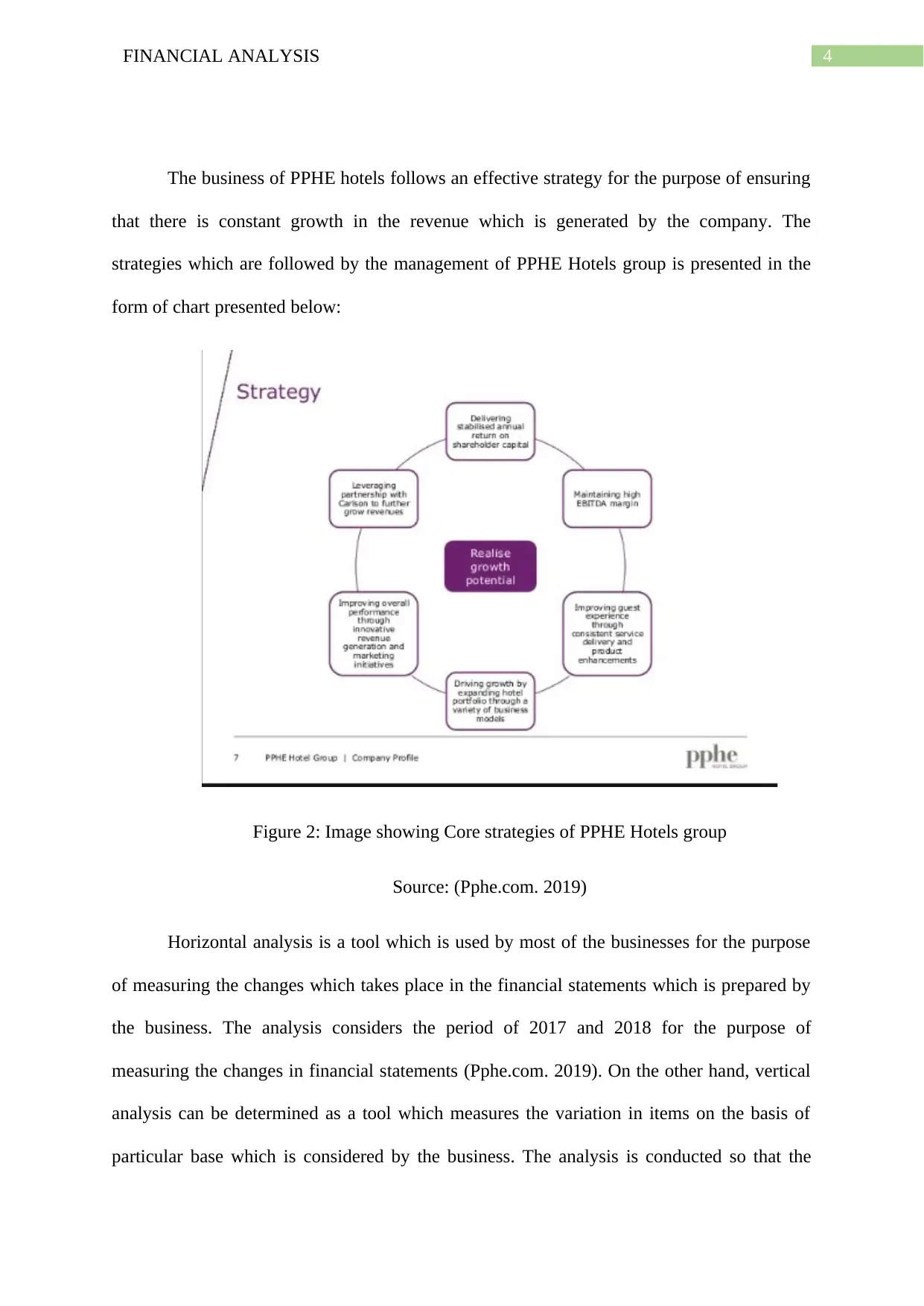
4FINANCIAL ANALYSIS
The business of PPHE hotels follows an effective strategy for the purpose of ensuring
that there is constant growth in the revenue which is generated by the company. The
strategies which are followed by the management of PPHE Hotels group is presented in the
form of chart presented below:
Figure 2: Image showing Core strategies of PPHE Hotels group
Source: (Pphe.com. 2019)
Horizontal analysis is a tool which is used by most of the businesses for the purpose
of measuring the changes which takes place in the financial statements which is prepared by
the business. The analysis considers the period of 2017 and 2018 for the purpose of
measuring the changes in financial statements (Pphe.com. 2019). On the other hand, vertical
analysis can be determined as a tool which measures the variation in items on the basis of
particular base which is considered by the business. The analysis is conducted so that the
The business of PPHE hotels follows an effective strategy for the purpose of ensuring
that there is constant growth in the revenue which is generated by the company. The
strategies which are followed by the management of PPHE Hotels group is presented in the
form of chart presented below:
Figure 2: Image showing Core strategies of PPHE Hotels group
Source: (Pphe.com. 2019)
Horizontal analysis is a tool which is used by most of the businesses for the purpose
of measuring the changes which takes place in the financial statements which is prepared by
the business. The analysis considers the period of 2017 and 2018 for the purpose of
measuring the changes in financial statements (Pphe.com. 2019). On the other hand, vertical
analysis can be determined as a tool which measures the variation in items on the basis of
particular base which is considered by the business. The analysis is conducted so that the
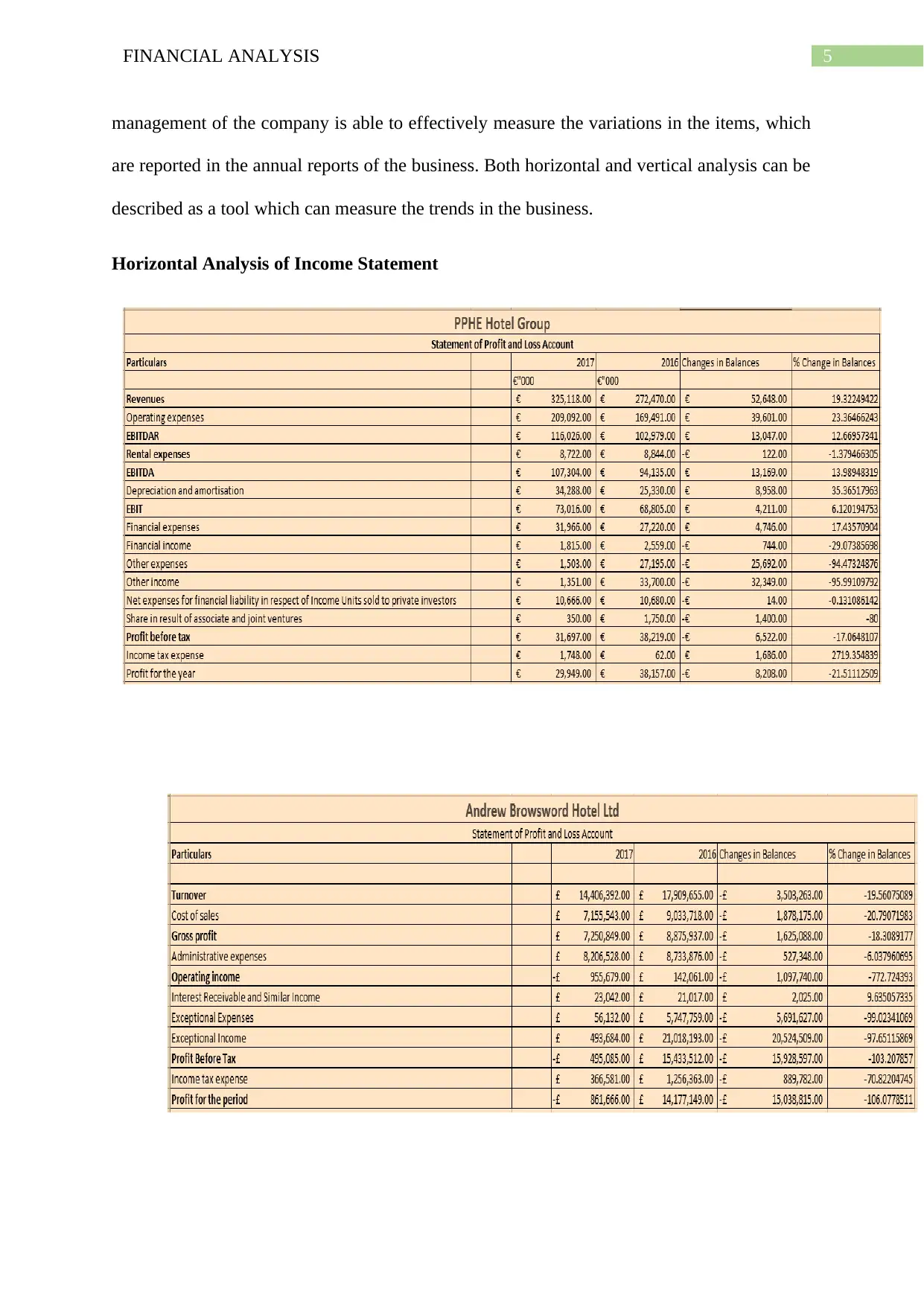
5FINANCIAL ANALYSIS
management of the company is able to effectively measure the variations in the items, which
are reported in the annual reports of the business. Both horizontal and vertical analysis can be
described as a tool which can measure the trends in the business.
Horizontal Analysis of Income Statement
management of the company is able to effectively measure the variations in the items, which
are reported in the annual reports of the business. Both horizontal and vertical analysis can be
described as a tool which can measure the trends in the business.
Horizontal Analysis of Income Statement
⊘ This is a preview!⊘
Do you want full access?
Subscribe today to unlock all pages.

Trusted by 1+ million students worldwide
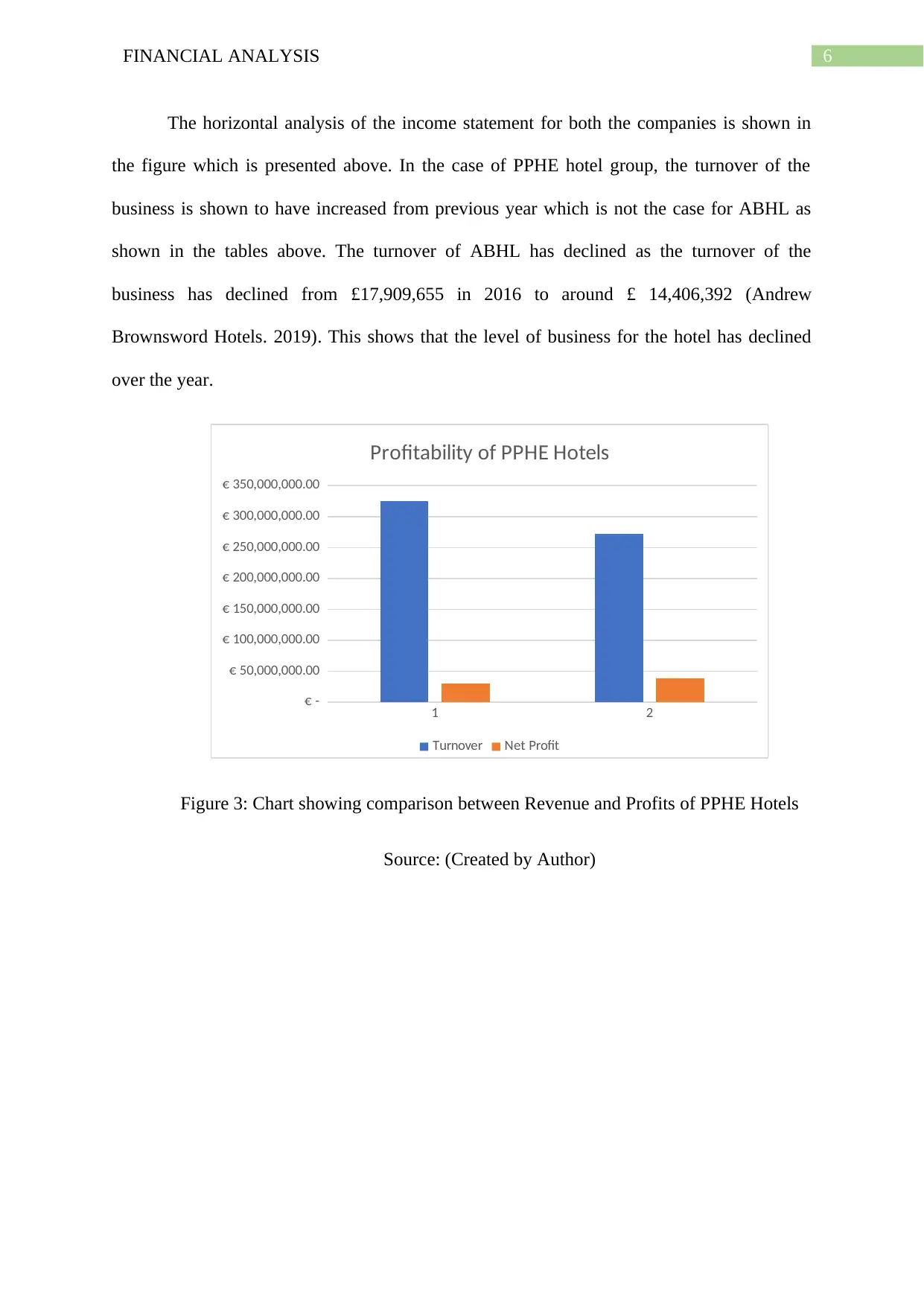
6FINANCIAL ANALYSIS
The horizontal analysis of the income statement for both the companies is shown in
the figure which is presented above. In the case of PPHE hotel group, the turnover of the
business is shown to have increased from previous year which is not the case for ABHL as
shown in the tables above. The turnover of ABHL has declined as the turnover of the
business has declined from £17,909,655 in 2016 to around £ 14,406,392 (Andrew
Brownsword Hotels. 2019). This shows that the level of business for the hotel has declined
over the year.
1 2
€ -
€ 50,000,000.00
€ 100,000,000.00
€ 150,000,000.00
€ 200,000,000.00
€ 250,000,000.00
€ 300,000,000.00
€ 350,000,000.00
Profitability of PPHE Hotels
Turnover Net Profit
Figure 3: Chart showing comparison between Revenue and Profits of PPHE Hotels
Source: (Created by Author)
The horizontal analysis of the income statement for both the companies is shown in
the figure which is presented above. In the case of PPHE hotel group, the turnover of the
business is shown to have increased from previous year which is not the case for ABHL as
shown in the tables above. The turnover of ABHL has declined as the turnover of the
business has declined from £17,909,655 in 2016 to around £ 14,406,392 (Andrew
Brownsword Hotels. 2019). This shows that the level of business for the hotel has declined
over the year.
1 2
€ -
€ 50,000,000.00
€ 100,000,000.00
€ 150,000,000.00
€ 200,000,000.00
€ 250,000,000.00
€ 300,000,000.00
€ 350,000,000.00
Profitability of PPHE Hotels
Turnover Net Profit
Figure 3: Chart showing comparison between Revenue and Profits of PPHE Hotels
Source: (Created by Author)
Paraphrase This Document
Need a fresh take? Get an instant paraphrase of this document with our AI Paraphraser
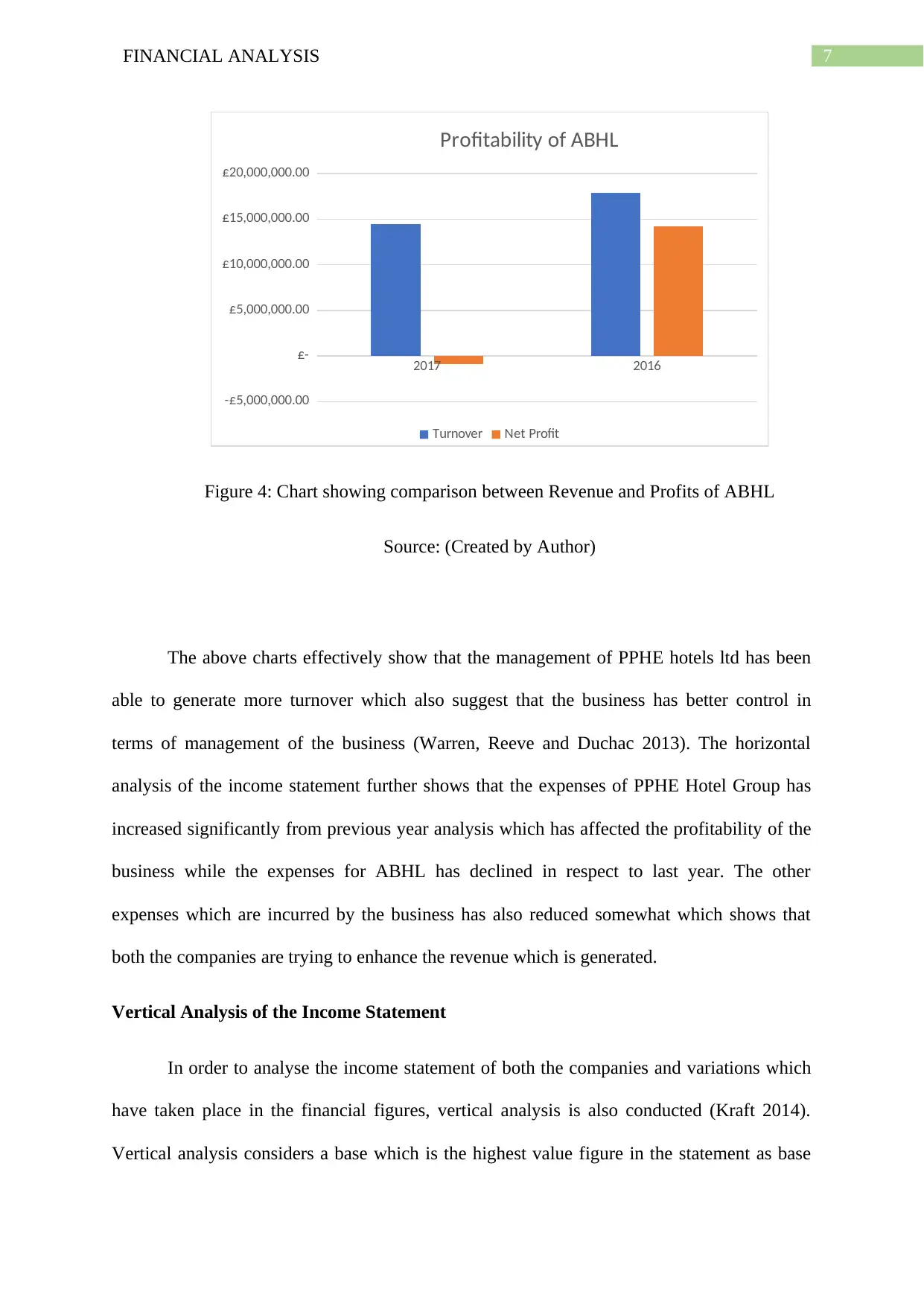
7FINANCIAL ANALYSIS
2017 2016
-£5,000,000.00
£-
£5,000,000.00
£10,000,000.00
£15,000,000.00
£20,000,000.00
Profitability of ABHL
Turnover Net Profit
Figure 4: Chart showing comparison between Revenue and Profits of ABHL
Source: (Created by Author)
The above charts effectively show that the management of PPHE hotels ltd has been
able to generate more turnover which also suggest that the business has better control in
terms of management of the business (Warren, Reeve and Duchac 2013). The horizontal
analysis of the income statement further shows that the expenses of PPHE Hotel Group has
increased significantly from previous year analysis which has affected the profitability of the
business while the expenses for ABHL has declined in respect to last year. The other
expenses which are incurred by the business has also reduced somewhat which shows that
both the companies are trying to enhance the revenue which is generated.
Vertical Analysis of the Income Statement
In order to analyse the income statement of both the companies and variations which
have taken place in the financial figures, vertical analysis is also conducted (Kraft 2014).
Vertical analysis considers a base which is the highest value figure in the statement as base
2017 2016
-£5,000,000.00
£-
£5,000,000.00
£10,000,000.00
£15,000,000.00
£20,000,000.00
Profitability of ABHL
Turnover Net Profit
Figure 4: Chart showing comparison between Revenue and Profits of ABHL
Source: (Created by Author)
The above charts effectively show that the management of PPHE hotels ltd has been
able to generate more turnover which also suggest that the business has better control in
terms of management of the business (Warren, Reeve and Duchac 2013). The horizontal
analysis of the income statement further shows that the expenses of PPHE Hotel Group has
increased significantly from previous year analysis which has affected the profitability of the
business while the expenses for ABHL has declined in respect to last year. The other
expenses which are incurred by the business has also reduced somewhat which shows that
both the companies are trying to enhance the revenue which is generated.
Vertical Analysis of the Income Statement
In order to analyse the income statement of both the companies and variations which
have taken place in the financial figures, vertical analysis is also conducted (Kraft 2014).
Vertical analysis considers a base which is the highest value figure in the statement as base

8FINANCIAL ANALYSIS
on the basis of which percentage of different items are computed. In this case, the total
revenue generated by both the hotels are considered to be the base.
The table which are presented in the above figure shows that in case of both the
businesses, the figure of sales is considered as the base and on the basis of the same different
percentage are computed.
on the basis of which percentage of different items are computed. In this case, the total
revenue generated by both the hotels are considered to be the base.
The table which are presented in the above figure shows that in case of both the
businesses, the figure of sales is considered as the base and on the basis of the same different
percentage are computed.
⊘ This is a preview!⊘
Do you want full access?
Subscribe today to unlock all pages.

Trusted by 1+ million students worldwide
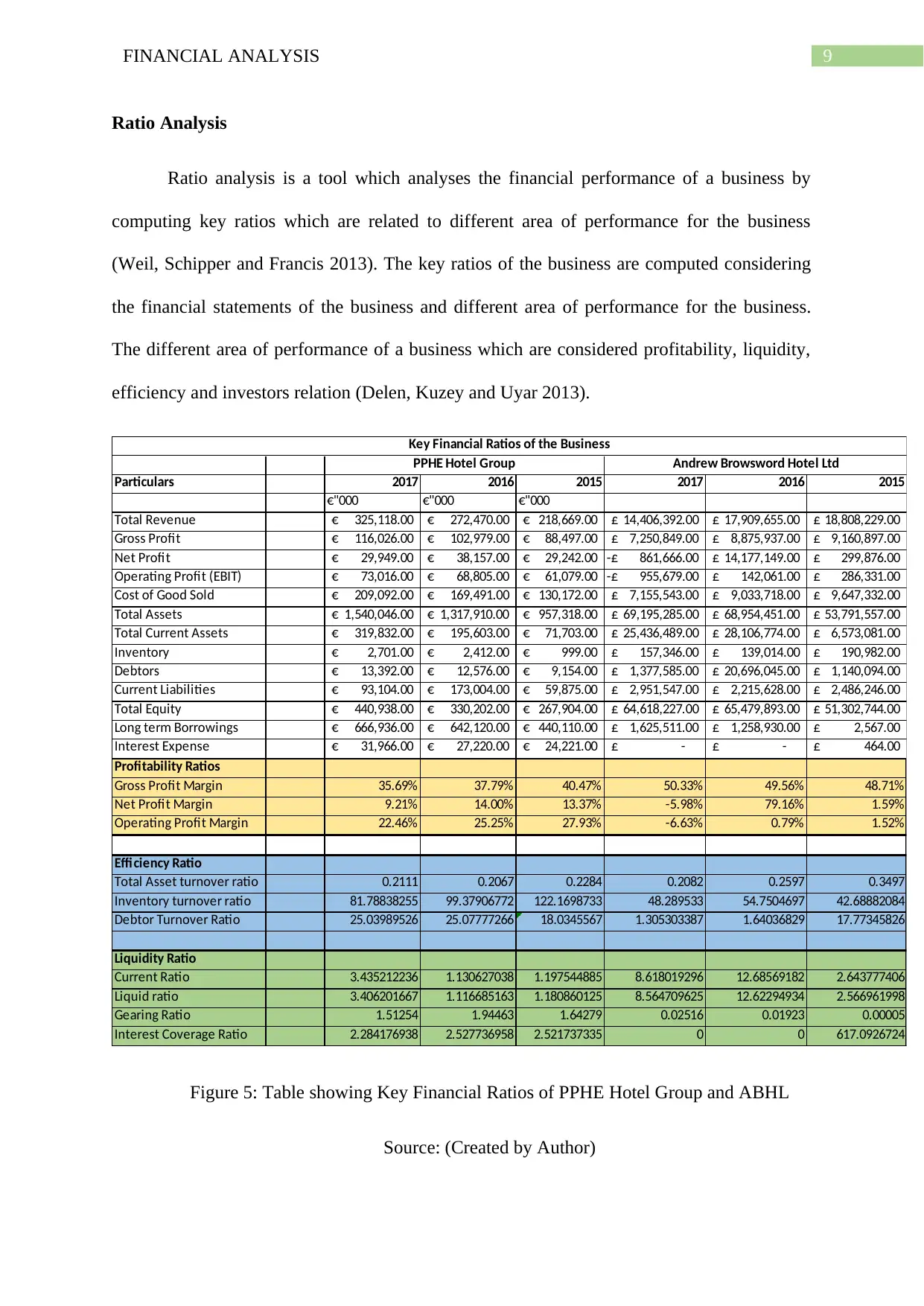
9FINANCIAL ANALYSIS
Ratio Analysis
Ratio analysis is a tool which analyses the financial performance of a business by
computing key ratios which are related to different area of performance for the business
(Weil, Schipper and Francis 2013). The key ratios of the business are computed considering
the financial statements of the business and different area of performance for the business.
The different area of performance of a business which are considered profitability, liquidity,
efficiency and investors relation (Delen, Kuzey and Uyar 2013).
Particulars 2017 2016 2015 2017 2016 2015
€"000 €"000 €"000
Total Revenue 325,118.00€ 272,470.00€ 218,669.00€ 14,406,392.00£ 17,909,655.00£ 18,808,229.00£
Gross Profit 116,026.00€ 102,979.00€ 88,497.00€ 7,250,849.00£ 8,875,937.00£ 9,160,897.00£
Net Profit 29,949.00€ 38,157.00€ 29,242.00€ 861,666.00-£ 14,177,149.00£ 299,876.00£
Operating Profit (EBIT) 73,016.00€ 68,805.00€ 61,079.00€ 955,679.00-£ 142,061.00£ 286,331.00£
Cost of Good Sold 209,092.00€ 169,491.00€ 130,172.00€ 7,155,543.00£ 9,033,718.00£ 9,647,332.00£
Total Assets 1,540,046.00€ 1,317,910.00€ 957,318.00€ 69,195,285.00£ 68,954,451.00£ 53,791,557.00£
Total Current Assets 319,832.00€ 195,603.00€ 71,703.00€ 25,436,489.00£ 28,106,774.00£ 6,573,081.00£
Inventory 2,701.00€ 2,412.00€ 999.00€ 157,346.00£ 139,014.00£ 190,982.00£
Debtors 13,392.00€ 12,576.00€ 9,154.00€ 1,377,585.00£ 20,696,045.00£ 1,140,094.00£
Current Liabilities 93,104.00€ 173,004.00€ 59,875.00€ 2,951,547.00£ 2,215,628.00£ 2,486,246.00£
Total Equity 440,938.00€ 330,202.00€ 267,904.00€ 64,618,227.00£ 65,479,893.00£ 51,302,744.00£
Long term Borrowings 666,936.00€ 642,120.00€ 440,110.00€ 1,625,511.00£ 1,258,930.00£ 2,567.00£
Interest Expense 31,966.00€ 27,220.00€ 24,221.00€ -£ -£ 464.00£
Profitability Ratios
Gross Profit Margin 35.69% 37.79% 40.47% 50.33% 49.56% 48.71%
Net Profit Margin 9.21% 14.00% 13.37% -5.98% 79.16% 1.59%
Operating Profit Margin 22.46% 25.25% 27.93% -6.63% 0.79% 1.52%
Efficiency Ratio
Total Asset turnover ratio 0.2111 0.2067 0.2284 0.2082 0.2597 0.3497
Inventory turnover ratio 81.78838255 99.37906772 122.1698733 48.289533 54.7504697 42.68882084
Debtor Turnover Ratio 25.03989526 25.07777266 18.0345567 1.305303387 1.64036829 17.77345826
Liquidity Ratio
Current Ratio 3.435212236 1.130627038 1.197544885 8.618019296 12.68569182 2.643777406
Liquid ratio 3.406201667 1.116685163 1.180860125 8.564709625 12.62294934 2.566961998
Gearing Ratio 1.51254 1.94463 1.64279 0.02516 0.01923 0.00005
Interest Coverage Ratio 2.284176938 2.527736958 2.521737335 0 0 617.0926724
PPHE Hotel Group
Key Financial Ratios of the Business
Andrew Browsword Hotel Ltd
Figure 5: Table showing Key Financial Ratios of PPHE Hotel Group and ABHL
Source: (Created by Author)
Ratio Analysis
Ratio analysis is a tool which analyses the financial performance of a business by
computing key ratios which are related to different area of performance for the business
(Weil, Schipper and Francis 2013). The key ratios of the business are computed considering
the financial statements of the business and different area of performance for the business.
The different area of performance of a business which are considered profitability, liquidity,
efficiency and investors relation (Delen, Kuzey and Uyar 2013).
Particulars 2017 2016 2015 2017 2016 2015
€"000 €"000 €"000
Total Revenue 325,118.00€ 272,470.00€ 218,669.00€ 14,406,392.00£ 17,909,655.00£ 18,808,229.00£
Gross Profit 116,026.00€ 102,979.00€ 88,497.00€ 7,250,849.00£ 8,875,937.00£ 9,160,897.00£
Net Profit 29,949.00€ 38,157.00€ 29,242.00€ 861,666.00-£ 14,177,149.00£ 299,876.00£
Operating Profit (EBIT) 73,016.00€ 68,805.00€ 61,079.00€ 955,679.00-£ 142,061.00£ 286,331.00£
Cost of Good Sold 209,092.00€ 169,491.00€ 130,172.00€ 7,155,543.00£ 9,033,718.00£ 9,647,332.00£
Total Assets 1,540,046.00€ 1,317,910.00€ 957,318.00€ 69,195,285.00£ 68,954,451.00£ 53,791,557.00£
Total Current Assets 319,832.00€ 195,603.00€ 71,703.00€ 25,436,489.00£ 28,106,774.00£ 6,573,081.00£
Inventory 2,701.00€ 2,412.00€ 999.00€ 157,346.00£ 139,014.00£ 190,982.00£
Debtors 13,392.00€ 12,576.00€ 9,154.00€ 1,377,585.00£ 20,696,045.00£ 1,140,094.00£
Current Liabilities 93,104.00€ 173,004.00€ 59,875.00€ 2,951,547.00£ 2,215,628.00£ 2,486,246.00£
Total Equity 440,938.00€ 330,202.00€ 267,904.00€ 64,618,227.00£ 65,479,893.00£ 51,302,744.00£
Long term Borrowings 666,936.00€ 642,120.00€ 440,110.00€ 1,625,511.00£ 1,258,930.00£ 2,567.00£
Interest Expense 31,966.00€ 27,220.00€ 24,221.00€ -£ -£ 464.00£
Profitability Ratios
Gross Profit Margin 35.69% 37.79% 40.47% 50.33% 49.56% 48.71%
Net Profit Margin 9.21% 14.00% 13.37% -5.98% 79.16% 1.59%
Operating Profit Margin 22.46% 25.25% 27.93% -6.63% 0.79% 1.52%
Efficiency Ratio
Total Asset turnover ratio 0.2111 0.2067 0.2284 0.2082 0.2597 0.3497
Inventory turnover ratio 81.78838255 99.37906772 122.1698733 48.289533 54.7504697 42.68882084
Debtor Turnover Ratio 25.03989526 25.07777266 18.0345567 1.305303387 1.64036829 17.77345826
Liquidity Ratio
Current Ratio 3.435212236 1.130627038 1.197544885 8.618019296 12.68569182 2.643777406
Liquid ratio 3.406201667 1.116685163 1.180860125 8.564709625 12.62294934 2.566961998
Gearing Ratio 1.51254 1.94463 1.64279 0.02516 0.01923 0.00005
Interest Coverage Ratio 2.284176938 2.527736958 2.521737335 0 0 617.0926724
PPHE Hotel Group
Key Financial Ratios of the Business
Andrew Browsword Hotel Ltd
Figure 5: Table showing Key Financial Ratios of PPHE Hotel Group and ABHL
Source: (Created by Author)
Paraphrase This Document
Need a fresh take? Get an instant paraphrase of this document with our AI Paraphraser
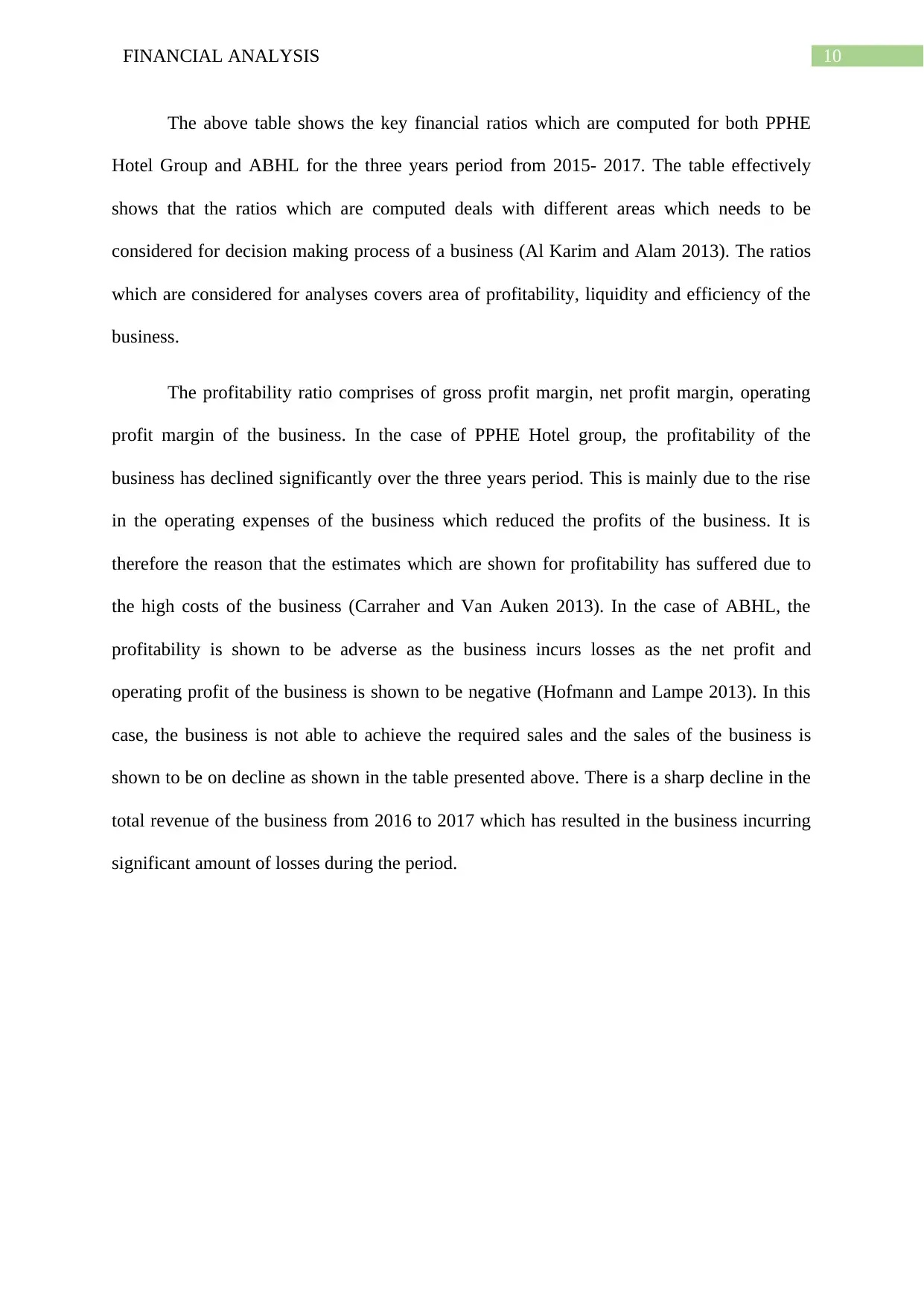
10FINANCIAL ANALYSIS
The above table shows the key financial ratios which are computed for both PPHE
Hotel Group and ABHL for the three years period from 2015- 2017. The table effectively
shows that the ratios which are computed deals with different areas which needs to be
considered for decision making process of a business (Al Karim and Alam 2013). The ratios
which are considered for analyses covers area of profitability, liquidity and efficiency of the
business.
The profitability ratio comprises of gross profit margin, net profit margin, operating
profit margin of the business. In the case of PPHE Hotel group, the profitability of the
business has declined significantly over the three years period. This is mainly due to the rise
in the operating expenses of the business which reduced the profits of the business. It is
therefore the reason that the estimates which are shown for profitability has suffered due to
the high costs of the business (Carraher and Van Auken 2013). In the case of ABHL, the
profitability is shown to be adverse as the business incurs losses as the net profit and
operating profit of the business is shown to be negative (Hofmann and Lampe 2013). In this
case, the business is not able to achieve the required sales and the sales of the business is
shown to be on decline as shown in the table presented above. There is a sharp decline in the
total revenue of the business from 2016 to 2017 which has resulted in the business incurring
significant amount of losses during the period.
The above table shows the key financial ratios which are computed for both PPHE
Hotel Group and ABHL for the three years period from 2015- 2017. The table effectively
shows that the ratios which are computed deals with different areas which needs to be
considered for decision making process of a business (Al Karim and Alam 2013). The ratios
which are considered for analyses covers area of profitability, liquidity and efficiency of the
business.
The profitability ratio comprises of gross profit margin, net profit margin, operating
profit margin of the business. In the case of PPHE Hotel group, the profitability of the
business has declined significantly over the three years period. This is mainly due to the rise
in the operating expenses of the business which reduced the profits of the business. It is
therefore the reason that the estimates which are shown for profitability has suffered due to
the high costs of the business (Carraher and Van Auken 2013). In the case of ABHL, the
profitability is shown to be adverse as the business incurs losses as the net profit and
operating profit of the business is shown to be negative (Hofmann and Lampe 2013). In this
case, the business is not able to achieve the required sales and the sales of the business is
shown to be on decline as shown in the table presented above. There is a sharp decline in the
total revenue of the business from 2016 to 2017 which has resulted in the business incurring
significant amount of losses during the period.
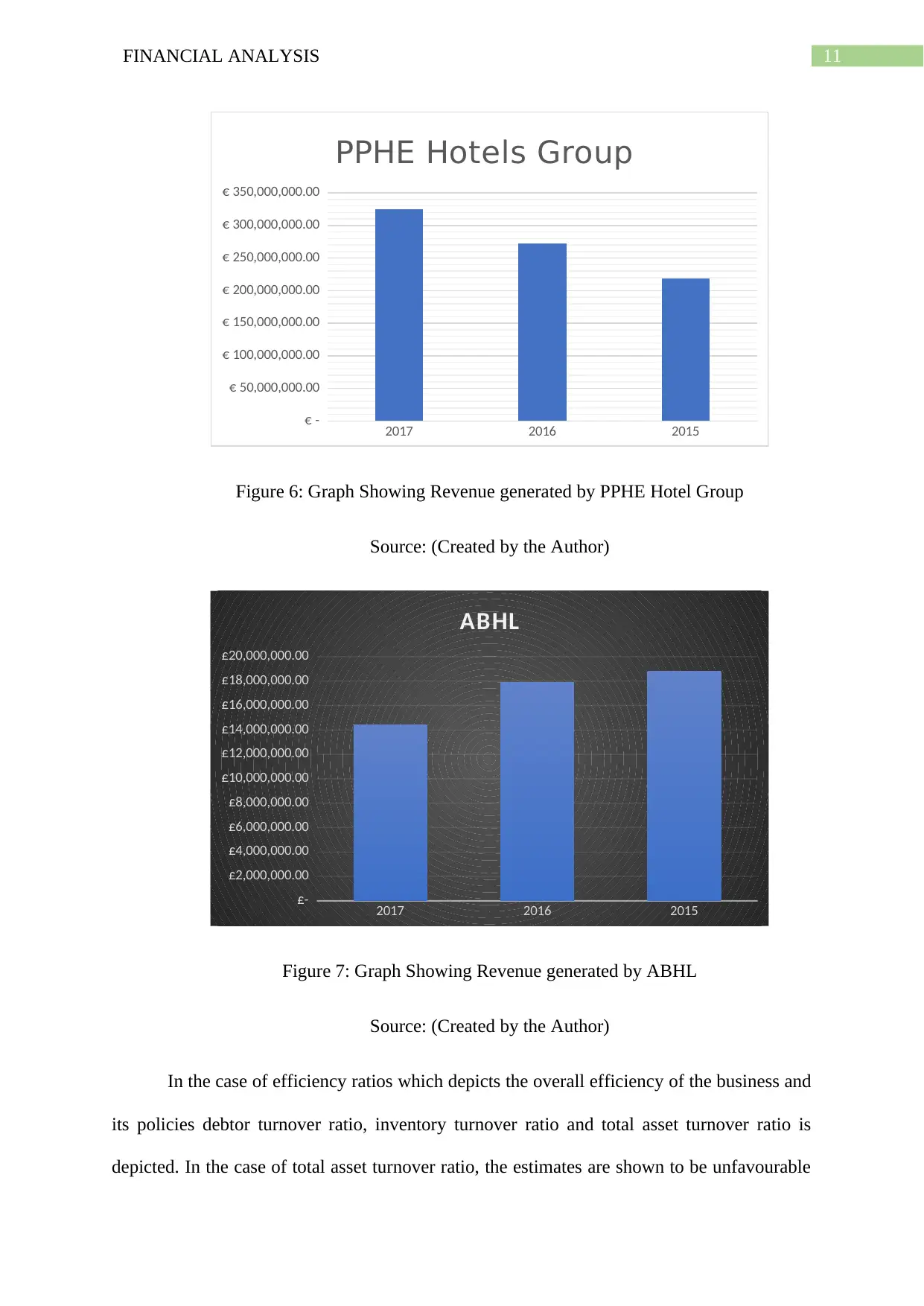
11FINANCIAL ANALYSIS
2017 2016 2015
€ -
€ 50,000,000.00
€ 100,000,000.00
€ 150,000,000.00
€ 200,000,000.00
€ 250,000,000.00
€ 300,000,000.00
€ 350,000,000.00
PPHE Hotels Group
Figure 6: Graph Showing Revenue generated by PPHE Hotel Group
Source: (Created by the Author)
2017 2016 2015
£-
£2,000,000.00
£4,000,000.00
£6,000,000.00
£8,000,000.00
£10,000,000.00
£12,000,000.00
£14,000,000.00
£16,000,000.00
£18,000,000.00
£20,000,000.00
ABHL
Figure 7: Graph Showing Revenue generated by ABHL
Source: (Created by the Author)
In the case of efficiency ratios which depicts the overall efficiency of the business and
its policies debtor turnover ratio, inventory turnover ratio and total asset turnover ratio is
depicted. In the case of total asset turnover ratio, the estimates are shown to be unfavourable
2017 2016 2015
€ -
€ 50,000,000.00
€ 100,000,000.00
€ 150,000,000.00
€ 200,000,000.00
€ 250,000,000.00
€ 300,000,000.00
€ 350,000,000.00
PPHE Hotels Group
Figure 6: Graph Showing Revenue generated by PPHE Hotel Group
Source: (Created by the Author)
2017 2016 2015
£-
£2,000,000.00
£4,000,000.00
£6,000,000.00
£8,000,000.00
£10,000,000.00
£12,000,000.00
£14,000,000.00
£16,000,000.00
£18,000,000.00
£20,000,000.00
ABHL
Figure 7: Graph Showing Revenue generated by ABHL
Source: (Created by the Author)
In the case of efficiency ratios which depicts the overall efficiency of the business and
its policies debtor turnover ratio, inventory turnover ratio and total asset turnover ratio is
depicted. In the case of total asset turnover ratio, the estimates are shown to be unfavourable
⊘ This is a preview!⊘
Do you want full access?
Subscribe today to unlock all pages.

Trusted by 1+ million students worldwide
1 out of 28
Related Documents
Your All-in-One AI-Powered Toolkit for Academic Success.
+13062052269
info@desklib.com
Available 24*7 on WhatsApp / Email
![[object Object]](/_next/static/media/star-bottom.7253800d.svg)
Unlock your academic potential
Copyright © 2020–2025 A2Z Services. All Rights Reserved. Developed and managed by ZUCOL.





